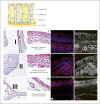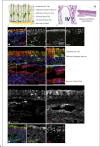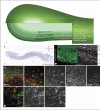Evidence of SARS-CoV2 Entry Protein ACE2 in the Human Nose and Olfactory Bulb
- PMID: 33486479
- PMCID: PMC7900466
- DOI: 10.1159/000513040
Evidence of SARS-CoV2 Entry Protein ACE2 in the Human Nose and Olfactory Bulb
Abstract
Usually, pandemic COVID-19 disease, caused by SARS-CoV2, presents with mild respiratory symptoms such as fever, cough, but frequently also with anosmia and neurological symptoms. Virus-cell fusion is mediated by angiotensin-converting enzyme 2 (ACE2) and transmembrane serine protease 2 (TMPRSS2) with their organ expression pattern determining viral tropism. Clinical presentation suggests rapid viral dissemination to the central nervous system leading frequently to severe symptoms including viral meningitis. Here, we provide a comprehensive expression landscape of ACE2 and TMPRSS2 proteins across human postmortem nasal and olfactory tissue. Sagittal sections through the human nose complemented with immunolabelling of respective cell types represent different anatomically defined regions including olfactory epithelium, respiratory epithelium of the nasal conchae and the paranasal sinuses along with the hardly accessible human olfactory bulb. ACE2 can be detected in the olfactory epithelium as well as in the respiratory epithelium of the nasal septum, the nasal conchae, and the paranasal sinuses. ACE2 is located in the sustentacular cells and in the glandular cells in the olfactory epithelium as well as in the basal cells, glandular cells, and epithelial cells of the respiratory epithelium. Intriguingly, ACE2 is not expressed in mature or immature olfactory receptor neurons and basal cells in the olfactory epithelium. Similarly, ACE2 is not localized in the olfactory receptor neurons albeit the olfactory bulb is positive. Vice versa, TMPRSS2 can also be detected in the sustentacular cells and the glandular cells of the olfactory epithelium. Our findings provide the basic anatomical evidence for the expression of ACE2 and TMPRSS2 in the human nose, olfactory epithelium, and olfactory bulb. Thus, they are substantial for future studies that aim to elucidate the symptom of SARS-CoV2 induced anosmia via the olfactory pathway.
Keywords: ACE2; Human; Olfactory bulb; Olfactory epithelium; SARS-CoV2.
© 2021 S. Karger AG, Basel.
Conflict of interest statement
The authors have no conflicts of interest to declare.
Figures




Similar articles
-
Expression of ACE2 and TMPRSS2 Proteins in the Upper and Lower Aerodigestive Tracts of Rats: Implications on COVID 19 Infections.Laryngoscope. 2021 Mar;131(3):E932-E939. doi: 10.1002/lary.29132. Epub 2020 Oct 19. Laryngoscope. 2021. PMID: 32940922
-
COVID-19 Anosmia: High Prevalence, Plural Neuropathogenic Mechanisms, and Scarce Neurotropism of SARS-CoV-2?Viruses. 2021 Nov 4;13(11):2225. doi: 10.3390/v13112225. Viruses. 2021. PMID: 34835030 Free PMC article. Review.
-
Expression Pattern of the SARS-CoV-2 Entry Genes ACE2 and TMPRSS2 in the Respiratory Tract.Viruses. 2020 Oct 16;12(10):1174. doi: 10.3390/v12101174. Viruses. 2020. PMID: 33081421 Free PMC article.
-
Expression of the SARS-CoV-2 Entry Proteins, ACE2 and TMPRSS2, in Cells of the Olfactory Epithelium: Identification of Cell Types and Trends with Age.ACS Chem Neurosci. 2020 Jun 3;11(11):1555-1562. doi: 10.1021/acschemneuro.0c00210. Epub 2020 May 19. ACS Chem Neurosci. 2020. PMID: 32379417 Free PMC article.
-
ACE2 & TMPRSS2 Expressions in Head & Neck Tissues: A Systematic Review.Head Neck Pathol. 2021 Mar;15(1):225-235. doi: 10.1007/s12105-020-01212-5. Epub 2020 Aug 20. Head Neck Pathol. 2021. PMID: 32816230 Free PMC article.
Cited by
-
Intranasal inoculation of IFN-λ resolves SARS-CoV-2 lung infection via the rapid reduction of viral burden and improvement of tissue damage.Front Immunol. 2022 Nov 29;13:1009424. doi: 10.3389/fimmu.2022.1009424. eCollection 2022. Front Immunol. 2022. PMID: 36524125 Free PMC article.
-
Organ manifestations of COVID-19: what have we learned so far (not only) from autopsies?Virchows Arch. 2022 Aug;481(2):139-159. doi: 10.1007/s00428-022-03319-2. Epub 2022 Apr 1. Virchows Arch. 2022. PMID: 35364700 Free PMC article. Review.
-
The angiotensin converting enzyme 2 (ACE2) system in the brain: possible involvement in Neuro-Covid.Histol Histopathol. 2021 Nov;36(11):1125-1131. doi: 10.14670/HH-18-356. Epub 2021 Jun 18. Histol Histopathol. 2021. PMID: 34142714 Review.
-
SARS-CoV-2 Infected Pediatric Cerebral Cortical Neurons: Transcriptomic Analysis and Potential Role of Toll-like Receptors in Pathogenesis.Int J Mol Sci. 2021 Jul 28;22(15):8059. doi: 10.3390/ijms22158059. Int J Mol Sci. 2021. PMID: 34360824 Free PMC article.
-
Knockout of angiotensin converting enzyme-2 receptor leads to morphological aberrations in rodent olfactory centers and dysfunctions associated with sense of smell.Front Neurosci. 2023 Jun 19;17:1180868. doi: 10.3389/fnins.2023.1180868. eCollection 2023. Front Neurosci. 2023. PMID: 37404465 Free PMC article.
References
-
- Au WW, Treloar HB, Greer CA. Sublaminar organization of the mouse olfactory bulb nerve layer. J Comp Neurol. 2002;446((1)):68–80. - PubMed
-
- Caggiano M, Kauer JS, Hunter DD. Globose basal cells are neuronal progenitors in the olfactory epithelium: a lineage analysis using a replication-incompetent retrovirus. Neuron. 1994;13((2)):339–52. - PubMed
MeSH terms
Substances
LinkOut - more resources
Full Text Sources
Other Literature Sources
Medical
Miscellaneous

